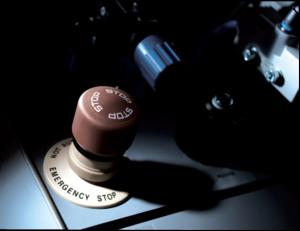Machinery safety is one of the most significant trends driving automation, and the integration of
technologies is key to advances in this area. Nigel Dawson surveys the developments making life easier
for those charged with the specification, control or day-to-day management of automation machinery
Machinery safety is one of the most significant trends driving automation, and the integration of
technologies is key to advances in this area. Nigel Dawson surveys the developments making life easier
for those charged with the specification, control or day-to-day management of automation machinery
Machinery safety plays a key
role but, there are many
different approaches and a
great deal of uncertainty among
machine builders and end users (and
safety managers) in how to handle these
issues and what degree of complexity
and cost they need to go to in order to
adequately minimise risks. Therefore, it
isn't surprising that nearly all of the
parties involved in the machinery safety
sector seek advice and support.
Frequently the machinery safety industry
is focused on electrically and
electronically monitored systems that end
at the motor. The question that needs to
be asked is who monitors the mechanics?
'Overall safety concepts' that integrate
clamping modules and linear feedback
systems onto electromechanical axis are
ideal mechanical measures, that when
combined with safety functions in the
drives and motors and specific electric
drive safety controllers allow the creation
of fully certified systems for category 4 /
PLe safety (from a single supplier with full
documentation and circuit diagrams).
In applications that are not protected by
physical safety guards, but where
personnel can come into direct contact
with plant components, the Machinery
Directive 2006/42/EC indicates systems
must provide adequate risk reduction
through integrated safety functions.
In many cases an 'overall safety
concept', requires the monitoring of
moving axis, as well as safety-related
clamping or braking, depending
on the expected
conditions. In higher risk
applications two
independent channels are
required. In the past,
machine builders would
often design in their own
safety solutions that took the safety
switching device and wired in the STO, or
Safe Torque Off, function. Frequently
servo motors have been replaced by a
motor and brake combination in vertical
applications.
However, there are several problems
with this approach; it does not take into
account all the possible failure states - a
coupling assembly breakage or slippage,
or a broken toothed belt in a parallel
mounting kit could render the brake
useless. These faults could still allow the
carriage and load to fall, causing damage
or injury. It's this sort of detail which
safety managers need to be aware of but
are often not sufficiently,
and understandably, technically
qualified to appreciate.
A fully integrated approach that
monitors both the axis of a machine and
allows safety-related clamping or braking
is the best, safest solution and this is
exactly what Festo's electric axis EGC unit
does. It has an optional second channel
displacement encoder and one or two
channel clamping unit. The mechanical
system can be monitored by both a motor
encoder (first channel) and the linear
displacement encoder (second channel)
mounted on the axis providing two
channel monitoring.
The axis can also be specified with
single or dual-channel clamping units
EGC-HPN which are suitable for holding
a position, collision protection and, due to
their emergency braking features, enhance
safety in any vertical axes, for example,
those which are typically used in lifting
and stacking applications.
With today's safety standards it is a
more complicated task for designers to
gather together all of the data from
different manufacturers to calculate and
document their own designed safety
solutions and it is even more difficult for
health and safety professionals to ensure
that their equipment providers have met
their legislative requirements.
Festo provides information on a wide
range of electric and pneumatic safety
functions through a Safety Guidelines
manual that can be downloaded from its
website www.festo.com and distributed
through the Machinery Safety Alliance
seminar program.
Nigel Dawson is GB product manager for
electric drives at Festo


